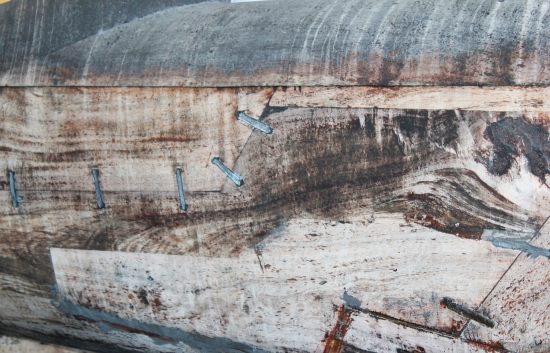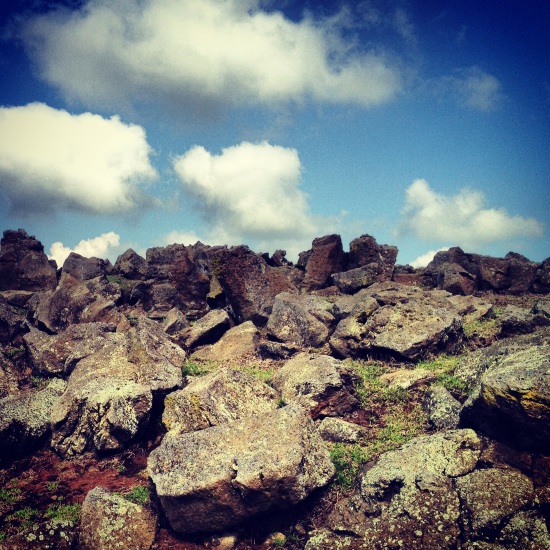
A koa tree in Keauhou Forest, Kaʻū.
I’m stump-ed. Literally! A part of me no longer knows up from down, sky from earth, tree branch from taproot. What once had definition is beginning to seep into new spaces, blurring boundaries. And I like it.
Now, before you stop reading, completely bewildered, let me explain. Perhaps starting at the beginning—or is it the end—will provide some clarity.
It all started yesterday.
Well, technically, it started twenty-one years ago. And as long as we’re being honest with ourselves, we may as well admit that it actually started generations before that. But, we won’t go there (at least not yet). For the time being, yesterday seems a bit more manageable.
That’s when I went to the forest. I followed behind a group of giggly 9 and 10 year olds who were so happy to be outdoors rather than in the classroom that no amount of rain, mud, or slipping and sliding could have dampened their excitement. In fact, for our children, it probably heightened it. With shoes coated in mud and clothes scented with rain, we walked along wet trails, allowing the trees to determine our path. At the head of our group was a man who had walked those trails before, twenty-one years before to be exact, in search of a canoe.
While we tend to think of canoes in terms of the waters they cross over, immediately associating them with the ocean, the fact is that they are born in the forest, with roots burrowing deep into the earth. As said in chant, “ʻOʻoki ka waʻa, hina i ka nahele.”[1] When a canoe is cut, it tumbles over in the forest. A tree is already seen as a canoe, standing tall in the uplands, before it is ever struck, before it is ever carved, and before it is ever sailed. For my people, then, perhaps the popular saying isn’t “See the forest for the trees”[2], but rather, “See the forest for the canoes.”
But that slight change in perspective isn’t what got me stump-ed. Let me continue my story, this time starting more than two decades ago.
A group of men once walked through the same forest. Yet, twenty-one years ago, the group of 9 and 10 year olds who giggled through the trees yesterday hadn’t yet been born. In fact, back then, I was the 9 year old, filled with the same innocent wonder. And it was at 9 that I first saw the canoe, the one that these men brought out of the forest and shaped with stone tools, the one they lashed with coconut sennit and rubbed down with kukui nut oil, the one they named Mauloa.[3] It is this canoe, twenty-one years later, that continues to carry their story.

From the hull of Mauloa
Yesterday, I hiked into the forest in search of the root of that story. Since the tree had tumbled over years before, we searched for its stump, for the part that symbolized its continued connection to its place of birth. I wanted to travel back to the beginning, to where it all began.
But, we never found it. And for reasons that I am only beginning to understand, perhaps we never needed to.
Because like the base of that tree, I’m stump-ed. In fact, we’re all stump-ed.
Generations ago, a seed sprouted. As it grew upward, it also grew downward: branches spreading across a stretch of blue sky, creating a canopy of dreams; and roots reaching through layers of soil, seeking nourishment for those dreams. When these men came upon the tree, standing tall, birds circling but never landing, they saw their canoe. With stone tools, they chipped away at its trunk. Red appeared beneath its bark while chips flew, cutting their skin. They both made a sacrifice, both bleeding for their cause. When the tree fell, and when the canoe was hauled to the shore, the stump remained. And with it, so did everything below the surface: a network of roots attached to the ground, attached to a specific place adorned with lehua and scented with maile.
We searched for the stump only as a means to locate its roots. But, as we searched and slipped through the forest, walking a circle, eventually looping back to the beginning, we realized we didn’t need to. Somewhere beneath our feet, beneath our mud-coated shoes and our rain-soaked jeans, was a system of roots, one that once nourished the tree above it. We walked the same land, looked up at some of the same trees. We knew we were in the right area, and in the end, we didn’t need to see the stump to be nourished by its roots.
Are you stump-ed yet? Perhaps this will clarify.
You see, our ancestors were masters of language, masters who recognized the connections between things that often seem disconnected, who knew that sometimes up is down, that sometimes sky is earth, that sometimes the tree branch is the taproot – one and the same, depending on how you look at it. In Hawaiian, the word for root is aʻa. It is the same word for vein, for artery, for tendon. Figuratively, it is the same word for womb and the same word for offspring.[4] ʻO ke aʻa kēia. This is the root. ʻO kaʻu aʻa kēia. This is my child. He kama au o ke aʻa hoʻokahi. I am a child of the same womb. We come from the same source.
Perhaps the same root that nourishes the tree and carries water to its branches is the same vein that carries blood to my heart. The same root that burrows deep into the earth is the same root that will travel over it. Aʻa grow upward as offspring as they also grow downward as roots. At different points in our lives we are both fed by aʻa and we become aʻa, nourished by that which is older and tasked with the responsibility to nourish all that will come after.
And through it all, we are always stump-ed. And we should be so, happily.
We are but the physical reminder of roots, deep roots, ancient roots. Our ancestors may not be visible, but they are there, a complex weave of aʻa, continually spreading underground. Without them, our land, our culture, and our people would erode, eventually drifting aimlessly out to sea. With them, we can travel far and wide, always carrying the sense of being rooted, knowing that we will always be stump-ed: a piece of ourselves will always be left back, grounded in the place that our ancestors’ roots are spread, holding the foundation of our identity together.
Perhaps it’s like Epeli Hauʻofa says:
“Wherever I am at any given moment, there is comfort in the knowledge stored at the back of my mind that somewhere in Oceania is a piece of earth to which I belong. In the turbulence of my life, it is my anchor. No one can take it away from me.”[5]
No matter where we go, there is a piece of ourselves that is, and will always be, stump-ed. It is the piece of ourselves that remains completely rooted to all that came before while the other part of ourselves travels in new directions. At some point in time, we’re all canoes standing in the forest, as the offspring, the aʻa, of those below the soil. And at some point, we all tumble over to begin a new journey. But that doesn’t disconnect us from the site of our roots because a part of ourselves—even when not seen physically—will always be stump-ed there, a reminder of that piece of earth to which we will always belong.

Koa trees at multiple stages.
[1] This line comes from a canoe chant as recorded in He Lei No ʻEmalani: Chants for Queen Emma Kaleleonālani, p. 268.
[2] “See the forest for the trees” is a popular idiom that refers to seeing the bigger pictures rather than just focusing on the details. To take a step back allows one to see so much more than if he/she were to focus solely on one thing alone. “Seeing the forest for the trees” or “for the canoes” allows us to see the interconnectedness between things.
[3] Mauloa is a 26-foot, single-hulled outrigger canoe built on the Big Island of Hawaiʻi and launched at Hōnaunau, Kona in 1993. For more information, visit http://www.nakalaiwaa.org/home
[5] This passage comes from Hauʻofa’s essay entitled “Pasts to Remember” from the book We Are Oceania: Selected Works, p. 76-77.








